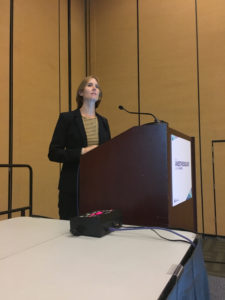More than one-half of all physicians report at least one major symptom of burnout, and anesthesiologists are especially affected, with a rate of burnout higher than the mean rate for all physicians. The high rate should not be surprising, as they are primed for burnout, said Amy E. Vinson, M.D., FAAP, of Boston Children’s Hospital and Harvard Medical School, Dr. Vinson led the Sunday session “Burnout in Anesthesiology Practices: Realities and Remedies.”
“Burnout starts with a compulsion to prove yourself, so you work harder and you neglect yourself and your needs,” said Dr. Vinson. “You displace internal conflicts and you revise your values. These first steps of the burnout cascade are taught, reinforced and rewarded throughout medical training.”

Amy E. Vinson, M.D., FAAP, discusses physician burnout and possible interventions.
Burnout causes a variety of physical and psychosocial symptoms that contribute to high rates of early retirement, substance abuse and suicide. Physician burnout also affects patient safety, with physicians self-reporting compromised patient care and medical errors.
Solutions have traditionally focused on individual-based interventions for clinicians, but the environment plays an important role. Dr. Vinson supports this with an analogy of the canary in the mineshaft.
“Imagine if the canary stopped singing, was removed from the mine, was revived and was put right back in the mine. Would the canary sing again?” she asked.
Creating a supportive environment is important for dealing with adverse events and medical errors. In a 2012 survey of ASA members, 88 percent of respondents said they needed time to recover emotionally after a perioperative catastrophe; 19 percent said they never recovered. Additionally, 67 percent said that their patient care was compromised over the next four hours, and 7 percent said they were not given time off after the incident. Supportive resources are vital in these situations, Dr. Vinson said.
She discussed the results of her own research on supportive resources for anesthesia residents after adverse events. Support programs were among the most efficacious resources, yet the least prevalent. When the resources were ranked according to both efficacy and utilization, the most high-yield resources were support programs, especially those that were resident-led; morbidity and mortality conferences; and individual meetings with department leadership. She said awareness of support programs should be heightened, and morbidity and mortality conferences should be improved to make them more supportive.
In other research, Dr. Vinson and colleagues identified key wellness topics for U.S. academic anesthesiology chairs. The top seven topics were related to system-level solutions: conflict management, dealing with adverse events training, stress management, burnout counseling, addiction counseling, peer-support programs and time management. The eight topics of least interest were related to individual-level solutions.
“The recognition that individual interventions are not the solution is encouraging,” said Dr. Vinson. “Solutions cannot focus solely on the individual. It’s not that these things aren’t vital. They are. It’s just not where the responsibility ends.”
Anesthesiology leaders play an important role in creating a culture of support. When leadership characteristics were studied in relation to burnout, the rate of burnout was lower among physicians who rated their direct supervisor favorably on a leadership characteristic.
“Leadership is a powerful peer support,” said Dr. Vinson. “And when I say ‘leader,’ I am talking to absolutely everyone in this room. Everyone is a leader to somebody. These leadership traits were similar in their effect, and you don’t have to take on all of them. Just pick one or two and get really good at them.”
Return to Archive Index